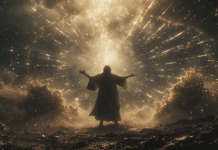
Before you begin…
Take a moment and breathe. Place your hand over your chest area, near your heart. Breathe slowly into the area for about a minute, focusing on a sense of ease entering your mind and body. Click here to learn why we suggest this.
“What you most need will be found where you least want to look, but you have to look purposefully. If it chases you, then you’re the prey; if you confront it, you can transcend it.” – Jordan Peterson
There is a lot written about shadow and what it is. The direction is clear. Shadow is something we repress and hide from others, and in most cases, from ourselves. Where does it originate and what can we do to integrate or heal it?
Let’s begin by asking ‘why we have a shadow?’ Is it because we carry darkness at our core or does the shadow take shape over our lifetime as residue of fear, rage, shame and guilt, and their avoidance? I’d say a little bit of both. On the human collective level, we carry trauma related to suffering and aggression of our ancestors. But for the most part, our shadow develops during this lifetime in the form of a complex and sophisticated personality, that keeps us with a sense of control.
Deep down we feel vulnerable but try to hide it
Our inner world is complex and for some, unbearable. We continuously face and fear exposure of our contradictory complexity, towards ourselves and others. Instead of delving into the depth of our psyche and inviting more consciousness, we would rather guard ourselves. The more conscious we are, the more responsible we become for our actions. One of the reasons we so meticulously hide our shadow is because we don’t want to carry the consequence of our actions. And so, our vulnerability and shadow are closely linked.
There are many effective ways not to feel vulnerable and retain a sense of innocence. Abiding by a strict morality, adhering to ideologies, be they social, political or spiritual, or relying on religious dogma, all achieve exactly that protection. The kind of protection in which we cradle ourselves in feelings of righteousness and innocence. This is not to imply we shouldn’t seek for our actions to be moral or avoid believing but to become aware when they are used in service of feeling superior over others. Interestingly enough, our wish to remain innocent is a big shadow in and of itself.
So, while we’re busy repressing and controlling, the shadow feeds and grows with every attempt to fight off rejection, humiliation or punishment, as well as situations that leave us feeling guilty and ashamed
Here are some examples of how our shadow hides our vulnerability. Let’s say we want to be recognized for something we’ve done. Instead of asking for acknowledgment, we hide it through false humility and become resentful for not getting the attention we feel we deserve. Another example is our need to belong and be important to others. But again, instead of communicating this need, which makes us vulnerable to rejection, we make others feel important in the hope of being praised for our actions. Over time we’ve developed innumerable sophisticated ways to sugarcoat our shadows and feel in control.
Shadow integration begins with an honesty that seeks nothing in return
We can see, that most shadow has to do with survival attempts of some kind. This happens when we try to control our environments by behaving as victims, gaining respect through false humility, moral superiority and other forms of manipulation. When we talk about shadow integration, it’s crucial we are precise as to what the facets of our shadow are.
We want to, for example, be able to say, while refraining from any judgment, that ‘I smile at others, in order not to be attacked’ or ‘I control my partner by making him or her feel guilty’. Any judgment of what we discover in ourselves is a hidden attempt at victimizing ourselves and finding excuses. The ‘why’ is of secondary importance here, because the list of reasons is endless and the absolute source is difficult to pinpoint, but the urge to limit our vulnerability is still there.
This may be a good moment to say, that shadow integration is not about redemption, but about understanding the inner workings of vulnerability and protection, which are closely linked to our sense of survival, both physical and emotional.
Furthermore, we want to face our shadows, not to feel better or lighter in the future, but in order to become more integrated within ourselves and lessen the sense of separation that the shadow produces. We want to return integrity that comes with the responsibility of belonging to a history and culture that experiences a great deal of suffering and is greater than our individual selves. Integrating our shadow implies allowing the darkness to be part of us, without the desire to surpass it.
Drop the hope for a pain-free life
When we face our shadow, we want to fully own the aggression, fear, selfishness or greed living inside us. We want to clarify first and foremost to ourselves how we play power games and seek control. This acknowledgment doesn’t necessarily reduce the hurt to ourselves or others or enable us to change. There is no certain outcome from shadow integration and that’s a tough pill to swallow. What we’re ‘simply’ doing, is bringing something hidden to light, without the attempt to make it more or less significant or dramatic, but rather see it as it is, thereby becoming more aware.
The more emotionality we induce into the characterization of our shadow, the less integration takes place. Shadow integration should be a non-dramatic act, surrounded by a hint of coolness, where we observe who we’ve become. We will feel the pain of lies, betrayal and hurt to others during this observation. And in the process of doing so, holding back judgment, positive or negative, is truly challenging. How is it possible ‘not to comment’ on what we regard as a personal experience? We need to understand that any commentary also contains the attempt to change the experience, be it freeing or punishing to us.
Healing the shadow is a magical process in which we are the participant, not the director
The great challenge in shadow integration is to grow our capacity to be with or hold an experience without having the ability to change it. What has been done is in the past and can’t be undone; it can only be held and by holding it patiently, more facets can emerge and be seen. Like when a child injures itself, we can only hold them to share the pain of waiting for healing to take place, but the magic of healing has its own mysterious timeline.
When we own our shadow, it puts us in a helpless and humbling place. It shows us our limitations and that is something we don’t want to feel. Maximizing our potential for our own feelings of greatness is just another shadow. Acknowledging the limitation of our potential, without minimizing our strength or exercising false humility, allows us to share our light.
Life comes with a lot of limitations and the shadow tries to interfere with life itself. Facing our shadow is a spiritual act as we embrace and allow a little more of our human totality to be included. Through this experience, we can get in touch with a humility and simplicity, that can often touch something at our core, which is mystically meaningful and expanding.
Integration comes from a place that is non-dramatic, because drama always takes sides, and it makes us miss the simplicity lying in the acknowledgment of human complexity. Shadow integration is a lifelong and even a magical process. It happens when we are completely truthful, giving up all deals with God or fate, and surrendering to what we essentially are: vulnerable. We want to invite feeling the pain our shadow reveals to us without seeking redemption. In a way, every time we say yes to a shadow part in us, we agree to re-enter continuous vulnerability of being human.
This is where integration begins.
Source: collective-evolution.com
Disclaimer: We at Prepare for Change (PFC) bring you information that is not offered by the mainstream news, and therefore may seem controversial. The opinions, views, statements, and/or information we present are not necessarily promoted, endorsed, espoused, or agreed to by Prepare for Change, its leadership Council, members, those who work with PFC, or those who read its content. However, they are hopefully provocative. Please use discernment! Use logical thinking, your own intuition and your own connection with Source, Spirit and Natural Laws to help you determine what is true and what is not. By sharing information and seeding dialogue, it is our goal to raise consciousness and awareness of higher truths to free us from enslavement of the matrix in this material realm.
 EN
EN FR
FR


























Excellent insight in this article! Thank you for the help!